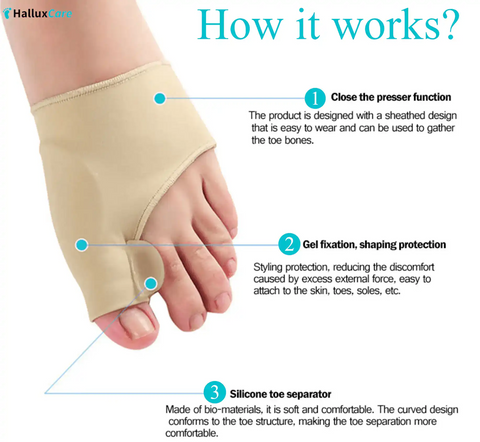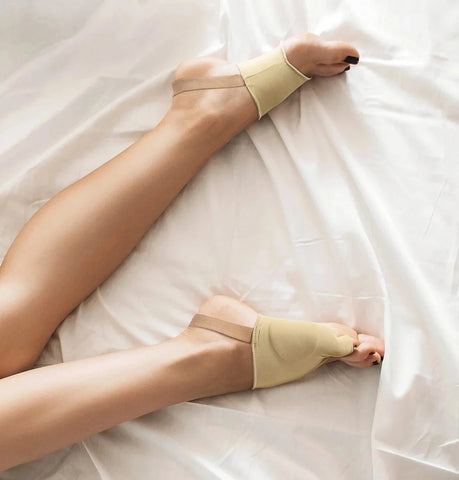Bunion Surgery: Should You Consider It?
Bunions can be both painful and frustrating, affecting mobility and overall foot health. Many individuals struggle with bunion discomfort for years before considering surgery. But is surgery the right choice for you? This guide explores when bunion surgery makes sense, what to expect, and alternative pain relief options.
🔑 Key Takeaways
- Bunions are bony bumps that develop due to genetics, improper footwear, or arthritis.
- Surgery is recommended for severe pain, mobility issues, or when conservative treatments fail.
- Recovery from bunion surgery can take 3-6 months, requiring patience and rehabilitation.
- Non-surgical treatments, such as bunion sleeves, toe spacers, and supportive footwear, can alleviate symptoms.
- Consulting a podiatrist is essential before deciding on surgery.
What Are Bunions and Why Do They Develop?
A bunion (hallux valgus) is a bony bump that forms at the base of the big toe. It develops when the big toe pushes against the adjacent toe, causing the joint to protrude outward.
Common Causes:
- Genetics – Family history of bunions.
- Improper Footwear – High heels and narrow shoes increase risk.
- Foot Structure Abnormalities – Certain foot shapes are more prone to bunions.
- Arthritis – Inflammatory conditions can contribute to joint misalignment.
If left untreated, bunions can worsen over time, leading to significant discomfort and mobility issues.
🔬 Expert Insight:
"Bunions are often hereditary, but improper footwear can accelerate their development. Wearing supportive shoes can help slow progression."
— Dr. Emily Carter, DPM, Board-Certified Podiatrist
When Should You Consider Bunion Surgery?
Surgery is often a last resort for bunions, but some individuals choose it for various reasons. Here are key factors to consider:
Signs You May Need Surgery:
- ✔️ Severe Pain – If walking or wearing shoes becomes unbearable.
- ✔️ Limited Mobility – When the bunion affects daily activities.
- ✔️ Chronic Inflammation – If non-surgical treatments no longer provide relief.
- ✔️ Toe Deformity – If the big toe starts overlapping others.
🩺 Medical Recommendation:
"If conservative treatments fail and bunions cause significant pain, surgical correction may be the best option."
— Dr. James O'Malley, Orthopedic Surgeon
If your bunion doesn’t cause pain or interfere with daily life, non-surgical treatments may be a better option.
What to Expect from Bunion Surgery
Bunion surgery (bunionectomy) is performed to correct joint misalignment and relieve pain. Here’s what you should know:
Types of Bunion Surgery:
- 🔹 Osteotomy – Bone is cut and realigned.
- 🔹 Exostectomy – Bump is removed, but joint alignment remains the same.
- 🔹 Arthrodesis – Joint is fused for severe cases.
Recovery Timeline:
- - First few weeks – Swelling and limited mobility.
- - 6-8 weeks – Gradual return to walking with support.
- - 3-6 months – Full recovery and return to normal footwear.
⚠️ Important Consideration:
While surgery can provide relief, it requires commitment to rehabilitation. Physical therapy and wearing the right shoes post-surgery are crucial for recovery.
Non-Surgical Alternatives for Bunion Relief
Not ready for surgery? There are effective ways to manage bunion pain and slow its progression.
Effective Bunion Treatments:
- ✅ Orthopedic bunion sleeves – Help realign the toe and relieve pressure.
- ✅ Toe spacers – Reduce friction and promote alignment.
- ✅ Supportive footwear – Wide-toe shoes prevent worsening.
- ✅ Stretching exercises – Improve foot flexibility and strength.
- ✅ Pain relief creams – Reduce inflammation and discomfort.
4.9 ⭐⭐⭐⭐⭐ ( 1843 reviews )
Final Thoughts: Is Surgery Worth It?
Bunion surgery can be life-changing for those in severe pain, but it isn’t always necessary. Exploring non-invasive treatments first is a smart approach, as many people find relief without surgery.
Would you consider bunion surgery, or have you found success with non-surgical treatments? Share your thoughts in the comments!
Frequently Asked Questions (FAQs)
❓ Can bunions go away without surgery?
No, bunions do not go away on their own. However, non-surgical treatments can help manage symptoms and slow progression.
❓ Is bunion surgery painful?
Post-surgical pain is common, but it can be managed with medications and proper aftercare.
❓ How long does it take to recover from bunion surgery?
Most patients recover in 3-6 months, depending on the procedure and individual healing.
❓ Can wearing the right shoes prevent bunions?
Proper footwear can help prevent bunion progression, but it may not stop them from forming if genetic factors are involved.
Recommended Bunion Relief Products
If you're looking for relief from bunion pain, consider using the Orthopedic Bunion Pain Relief & Correction Sleeve , which provides support and helps to alleviate discomfort.
For additional protection, the Tailor's Bunion Bunionette Pain Relief Protection Sleeves are designed to offer comfort and protection for bunionette pain.
To nourish and soothe the skin around bunions, as well as to promote healthy hair, consider the Jamaica Black Castor Oil Soothing Oil . Known for its moisturizing and anti-inflammatory properties, it helps alleviate discomfort around bunions and supports hair growth and scalp health.
📅 Last Updated: March 2025
👨⚕️ Author: Dr. Lisa Reynolds, DPM – Board-Certified Podiatrist
🔎 Disclaimer: This article is for informational purposes only and does not replace professional medical advice. Always consult a healthcare provider for diagnosis and treatment.




